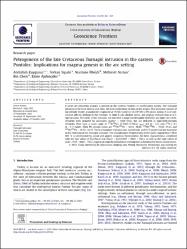Petrogenesis of the late Cretaceous Turnagöl intrusion in the eastern Pontides: Implications for magma genesis in the arc setting

Göster/
Erişim
info:eu-repo/semantics/restrictedAccessTarih
2012-09-28Erişim
info:eu-repo/semantics/restrictedAccessÜst veri
Tüm öğe kaydını gösterÖzet
A series of Cretaceous plutons is present in the eastern Pontides of northeastern Turkey. The Turnagöl intrusion is the least studied and, thus, the least understood plutons in the orogen. This intrusion consists of hornblende-biotite granodiorites emplaced at 78 Ma based on LA-ICP-MS U-Pb zircon dating. It is of subalkaline affinity, belongs to the medium- to high-K calc-alkaline series, and displays features typical of Itype granites. The rocks of the intrusion are enriched in large-ion lithophile elements and light rare earthelements with negative Eu anomalies (Eu/Eu* ¼ 0.69e0.82), but are deficient in high-field-strength elements. They have a small range of (87Sr/86Sr)i (0.7060e0.7063), 3Ndi ( 2.6 to 3.1), and d18O (?8.1 to ?9.1) values. Their Pb isotopic ratios are 206Pb/204Pb ¼ 18.63e18.65, 207Pb/204Pb ¼ 15.62e15.63, and 208Pb/204Pb ¼ 38.53e38.55. The fractionation of plagioclase, hornblende, and Fe-Ti oxides had key functions in the evolution of the Turnagöl intrusion. The crystallization temperatures of the melts ranged from 758 to 885 C as determined by zircon and apatite saturation thermometry. All these characteristics, combined with the low values of K2O/Na2O and (Na2O ? K2O)/(FeOt ? MgO ? TiO2), as well as the high values of (CaO?FeOt?MgO?TiO2), suggest an origin by dehydrationmelting fromametabasaltic lower crustal source.
Bağlantı
https://hdl.handle.net/20.500.12440/639https://reader.elsevier.com/reader/sd/pii/S1674987112001235?token=8C0629949D0267A4ADE98A0510CB5FEE50E6AFEF40C7C497E13A0C04B4D1F4F1503736111912FBBE806B740EA0E2C6B5&originRegion=eu-west-1&originCreation=20230317112857

















